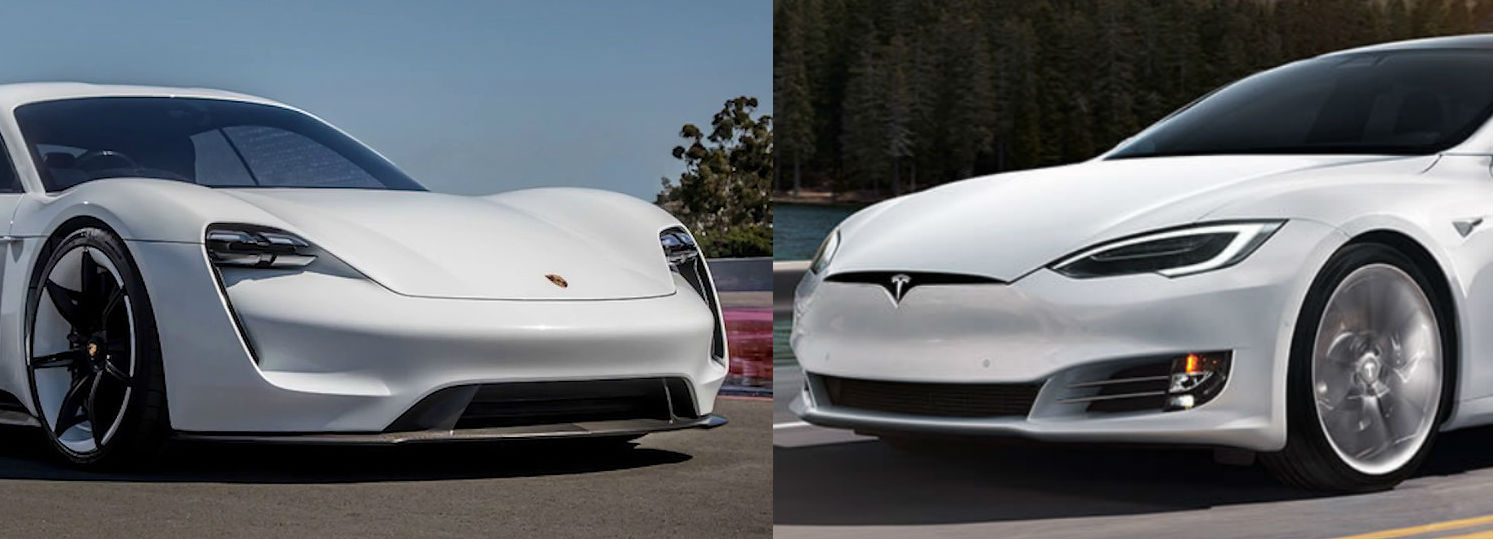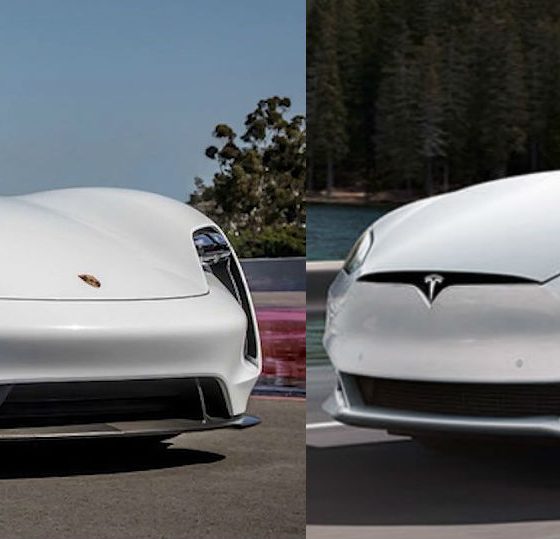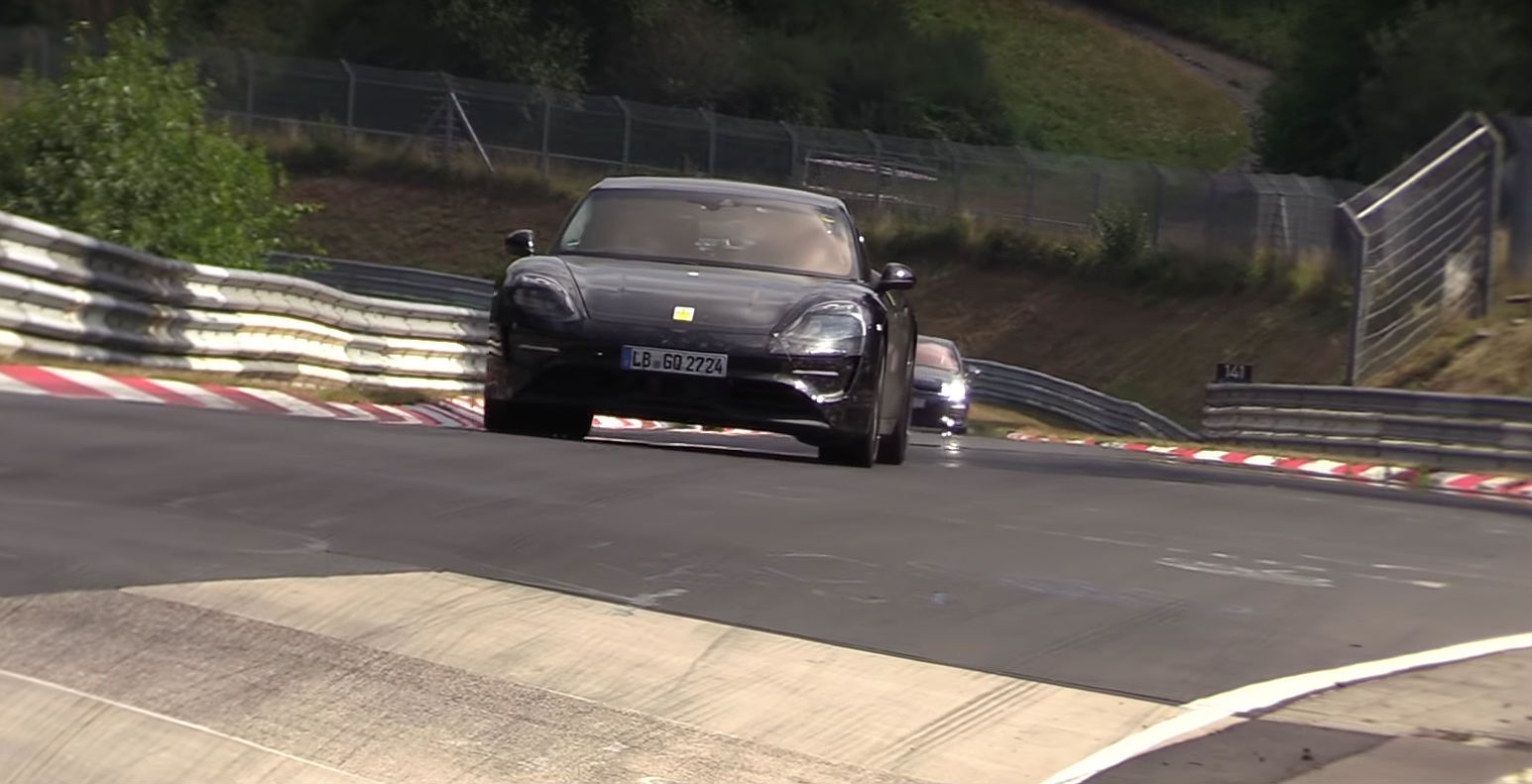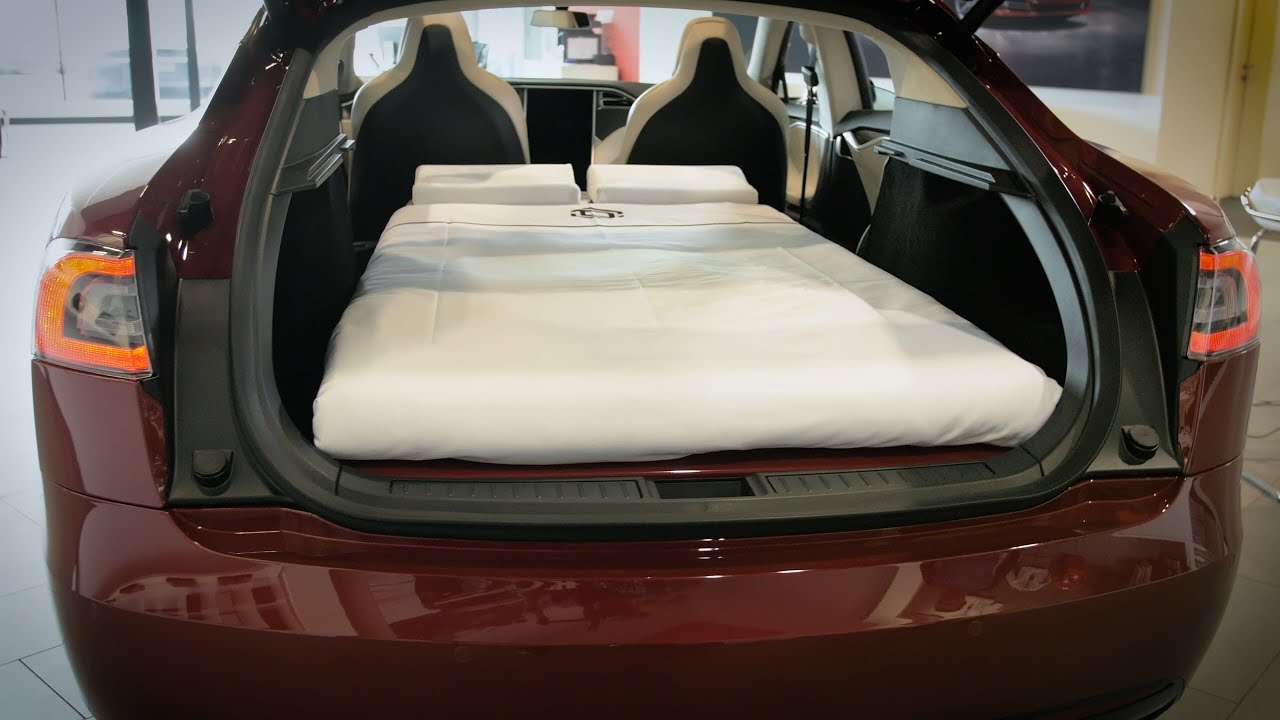

News
Porsche Taycan vs Tesla Model S: Powertrain, battery, performance, and features
The Tesla Model S has been sitting on top of the full-sized electric sedan market for a while now — and for good reason. The vehicle, after all, has played a huge part in changing the public’s perception of what electric cars are capable of. Fast, sleek, and equipped with real range, the Model S is a true no-compromises vehicle.
Among all the competitors for the Model S, there is one that is being developed to compete directly with the electric car. That is the Porsche Taycan, formerly known as the Mission E sedan. The Taycan made its debut during the 2015 Frankfurt Motor Show, and it has captured the imagination of EV enthusiasts ever since. Porsche is yet to unveil the production version of the Taycan, though it has several camouflaged units doing real-world tests today.
Porsche appears to be a legacy automaker that is really serious about making the Taycan a successful vehicle — so much so that the company actually released the car’s specs earlier this year. That said, how does the Taycan compare to the golden standard of four-door electric sedans? Here’s a brief comparison.
Powertrain
The Tesla Model S was initially released with an RWD option, though all variants of the vehicle today are now Dual Motor AWD. The Model S uses three-phase, four pole AC induction motors with copper rotors as its powertrain. The car is also equipped with a drive inverter with variable frequency drive and regenerative braking system.
In contrast, Porsche is using permanently excited synchronous motors (PSM) for the Taycan. In true Porsche tradition, the PSM motors are race-bred, having been used in the Porsche 919 Hybrid racecar. Naser Abu Daqqa, Porsche’s director of electric drive systems, notes that the coils used in the Taycan’s PSM motors are “made of wires that aren’t round, but rather rectangular, making it possible to pack the wires more tightly and get more copper into the coil machines—increasing power and torque with the same volume.”
Batteries and Charging
Tesla’s battery packs hold the standard as some of the finest in the industry. With the Model S, Tesla is using 75 kWh or 100 kWh microprocessor controlled, lithium-ion batteries. The Model S also uses 18650 cells as the components of its packs, which allow the vehicle to reach up to 315 miles per charge. The Tesla Model S is fully compatible with the ~120 kW Supercharger Network, which currently has more than 10,900 stalls worldwide.
The Porsche Taycan is set to use lithium-ion batteries as well. In a press release about the vehicle, the German legacy automaker noted that it would use 4-volt cells in the Taycan’s 800-volt battery pack. Porsche is designing the Taycan for rapid charging at speeds of up to ~350 kW through the upcoming IONITY Network, whose initial construction is underway.
The Porsche Taycan track testing at the Nurburgring.
Performance
The Tesla Model S has a reputation for being a family sedan that can humiliate supercars on the drag strip. The Model S P100D, the vehicle’s top trim, is capable of going from 0-60 mph in just 2.4 seconds with its Ludicrous Mode upgrade. The vehicle’s top speed is software-limited to 155 mph.
Porsche notes that the Taycan would have a 0-60 mph time of 3.5 seconds and a top speed of 155 mph. While this is not as quick as the top-tier Model S P100D, Porsche maintains that the Taycan would be able to handle extended track driving — an area that the Model S does not excel in. Porsche appears to be putting its foot where its mouth is with the Taycan’s track capabilities, as the vehicle has been spotted testing in the Nurburgring multiple times over the past few months.
Software
Tesla is noted for its Autopilot driver-assist system and firmware updates that add features to its vehicles. This was particularly exhibited last year when the company opted to “uncork” the 75D and 100D variants of the Model S and Model X, which lowered the vehicles’ 0-60 mph times. Tesla CEO Elon Musk also noted during the company’s Q2 2018 earnings call that Software V9 would be coming soon, which should introduce the first features of Tesla’s Full Self-Driving suite.
Porsche plans to feature the same system for the Taycan. In an interview with Autocar at the Geneva Motor Show, Porsche chairman Oliver Blume stated that the automaker is also looking to give the Taycan (then called the Mission E sedan) firmware upgrades that improve the car’s performance. Blume also alluded to some degree of self-driving for the vehicle, stating that “there are situations in traffic jams where you will be able to read a newspaper, but our customers take pleasure from driving and this will remain.”

Cargo Space
The Tesla Model S features a lot of space for cargo. The vehicle has a total cargo volume of 31.6 cu ft, comprised of 5.3 cu ft in the frunk, and 26.3 cu ft at the rear. With the back seats folded, the Model S features a very spacious 58.1 cu ft, which is enough to fit an inflatable twin mattress, for those times when drivers would prefer to sleep in their vehicles.
Porsche has not revealed the storage capacity of the Taycan yet, but Stefan Weckbach, the head of electric vehicles at the company, did mention that the car would have 100 liters of storage in the frunk. That’s about 3.53 cu ft, which is smaller than the Model S.
Price
The Model S 75D (the current base model) starts at $74,500, though higher trims like the supercar-slaying P100D could cost as much as $135,000. On the other hand, Porsche expects the Taycan to start at around the ~$75,000 – $85,000 range, putting it close to the price of an entry-level Panamera.
Availability
The Tesla Model S is currently available for purchase, though there are rumors that a refresh featuring an updated interior would be rolled out within the next few quarters. The Porsche Taycan, on the other hand, is expected to start production sometime in 2019, with deliveries likely hitting their stride around 2020.

News
Tesla 2025 Holiday Update: Here’s what it includes, and what it’s missing

Tesla has finally announced the features for the 2025 Holiday Update, which includes a wide variety of new inclusions that are both functional and just for fun.
The new features are plentiful, but there were a handful of things we were expecting to see based on what we know. We don’t want to sound ungrateful, because there are a lot of great new things on the way with this update.
Here’s what was included:
Grok with Navigation Commands (Beta)
Grok will now have the ability to add and edit navigation destinations, which is a drastic improvement considering Tesla owners had to use their standard voice commands for this in the past.

The utilization of Grok will likely improve the navigation experience by offering some insight into your destination, including reviews and other points of interest nearby.
It will be enabled by using Grok’s “Assistant” personality.
Tesla Photobooth
“Turn your car into a photobooth! Take selfies from inside your Tesla & give yourself a makeover with fun filters, stickers, and emojis. Share with others right from the Tesla app.”
This feature will be available within the Toybox.
Dog Mode Live Activity
When using Dog Mode to keep your four-legged friend comfortable in the car, you’ll now be able to check in on them as it will share periodic snapshots of the cabin, along with live updates on temperature, battery, and climate conditions.

Dashcam Viewer Update
Dashcam clips are awesome, but they’re void of a lot of information, which could be useful in some instances, especially if there is an accident.

Now, there will be additional details included on each Dashcam clip, like speed, steering wheel angle, and Self-Driving state.
Santa Mode
New graphics, trees, and a lock chime are now available.

Light Show Update
A new Light Show, called Jingle Rush, will be available.
Custom Wraps and License Plates in Colorizer
Colorizer will now be known as “Paint Shop” in the Toybox. You will now be able to personalize your Tesla Avatar with window tints, custom wraps, and license plates. Preloaded designs will be available, but owners will be able to use their USB Flash Drives to create one that suits their style.

Navigation Improvements
Changing the order of your destinations will be easier through a new “Favorites” tab, and Home and Work can now be set by dropping a pin.
There will also be “Suggested Destinations,” which will be determined through recent trips and habits while parked.
Supercharger Site Map
Perhaps the most significant feature of the Holiday Update, Tesla is adding a 3D view of select Tesla Superchargers by tapping “View Site Map.”
When navigating to a location with this capability, the site layout, live occupancy, and nearby amenities will be available. Drivers will also be able to choose which stall to Supercharge.

This is only available at a handful of locations currently, but it will expand to more Superchargers as it becomes more robust.
Automatic Carpool Lane Routing
Navigation will include an option to utilize carpool lanes. Your route will automatically choose the carpool lane when eligible.
Phone Left Behind Chime
If the in-car occupant detection system does not see anyone in the car and there is a phone key, or if a phone is left inside the cabin, your Tesla will chime a few seconds after the doors close.
Charge Limit Per Location
You can now save a charge limit for the current location while parked and it will be applied automatically the next time you charge there.
ISS Docking Simulator
In a SpaceX collaboration, Tesla has added this game to its in-car Arcade:
“Become an astronaut and prove your skills by docking with the International Space Station. Control & guide the rocket in this 3D docking simulator game using a set of controls based on actual interfaces used by NASA astronauts.”
Additional Improvements
-
Enable or disable wireless phone charging pads in Controls > Charging (S3XY) or Controls > Outlets & Mods (Cybertruck)
-
Add Spotify tracks to your queue right from the search screen & scroll through large Spotify playlists, albums, podcasts, audiobooks & your library seamlessly, without paging
-
Take the vibes up another level with rainbow colors during Rave Cave. Accent lights color will change along with the beats of your music. App Launcher > Toybox > Light Sync
-
Lock Sound now includes Light Cycle from Tron Mode. Toybox > Boombox > Lock Sound
What’s Missing
There are a handful of features we expected to see with the Holiday Update, but were not included.
Banish Feature
Tesla has been teasing the Banish functionality for quite a few years, but evidently, it is not quite there yet.
Banish will allow owners to get out of their vehicle at the entrance of their destination, and the car will go find a spot and park itself. Some refer to it as “Reverse Summon.”
Apple CarPlay
With all of the rumors regarding Apple CarPlay and then the evidence that Tesla was working to bring CarPlay to vehicles, we really expected it to come with the Holiday Update.
We’re not upset it’s not here, though. Tesla’s in-car UI is significantly better, at least in our opinion.
Parking Spot Selection
One of the biggest gripes about the new Arrival Features with Full Self-Driving v14 is that choosing a set parking spot is not available. This is especially frustrating for Tesla owners who rent or live in townhouse neighborhoods or apartment complexes with assigned parking.
Tesla seems to be working on this based on the release notes for v14.2, where it said future capabilities would include Parking Spot Selection.
News
Man credits Grok AI with saving his life after ER missed near-ruptured appendix
The AI flagged some of the man’s symptoms and urged him to return to the ER immediately and demand a CT scan.

A 49-year-old man has stated that xAI’s Grok ended up saving his life when the large language model identified a near-ruptured appendix that his first ER visit dismissed as acid reflux.
After being sent home from the ER, the man asked Grok to analyze his symptoms. The AI flagged some of the man’s symptoms and urged him to return immediately and demand a CT scan. The scan confirmed that something far worse than acid reflux was indeed going on.
Grok spotted what a doctor missed
In a post on Reddit, u/Tykjen noted that for 24 hours straight, he had a constant “razor-blade-level” abdominal pain that forced him into a fetal position. He had no fever or visible signs. He went to the ER, where a doctor pressed his soft belly, prescribed acid blockers, and sent him home.
The acid blockers didn’t work, and the man’s pain remained intense. He then decided to open a year-long chat he had with Grok and listed every detail that he was experiencing. The AI responded quickly. “Grok immediately flagged perforated ulcer or atypical appendicitis, told me the exact red-flag pattern I was describing, and basically said “go back right now and ask for a CT,” the man wrote in his post.
He copied Grok’s reasoning, returned to the ER, and insisted on the scan. The CT scan ultimately showed an inflamed appendix on the verge of rupture. Six hours later, the appendix was out. The man said the pain has completely vanished, and he woke up laughing under anesthesia. He was discharged the next day.
How a late-night conversation with Grok got me to demand the CT scan that saved my life from a ruptured appendix (December 2025)
byu/Tykjen ingrok
AI doctors could very well be welcomed
In the replies to his Reddit post, u/Tykjen further explained that he specifically avoided telling doctors that Grok, an AI, suggested he get a CT scan. “I did not tell them on the second visit that Grok recommended the CT scan. I had to lie. I told them my sister who’s a nurse told me to ask for the scan,” the man wrote.
One commenter noted that the use of AI in medicine will likely be welcomed, stating that “If AI could take doctors’ jobs one day, I will be happy. Doctors just don’t care anymore. It’s all a paycheck.” The Redditor replied with, “Sadly yes. That is what it felt like after the first visit. And the following night could have been my last.”
Elon Musk has been very optimistic about the potential of robots like Tesla Optimus in the medical field. Provided that they are able to achieve human-level articulation in their hands, and Tesla is able to bring down their cost through mass manufacturing, the era of AI-powered medical care could very well be closer than expected.
News
Tesla expands Model 3 lineup in Europe with most affordable variant yet
The Model 3 Standard still delivers more than 300 miles of range, potentially making it an attractive option for budget-conscious buyers.

Tesla has introduced a lower-priced Model 3 variant in Europe, expanding the lineup just two months after the vehicle’s U.S. debut. The Model 3 Standard still delivers more than 300 miles (480 km) of range, potentially making it an attractive option for budget-conscious buyers.
Tesla’s pricing strategy
The Model 3 Standard arrives as Tesla contends with declining registrations in several countries across Europe, where sales have not fully offset shifting consumer preferences. Many buyers have turned to options such as Volkswagen’s ID.3 and BYD’s Atto 3, both of which have benefited from aggressive pricing.
By removing select premium finishes and features, Tesla positioned the new Model 3 Standard as an “ultra-low cost of ownership” option of its all-electric sedan. Pricing comes in at €37,970 in Germany, NOK 330,056 in Norway, and SEK 449,990 in Sweden, depending on market. This places the Model 3 Standard well below the “premium” Model 3 trim, which starts at €45,970 in Germany.
Deliveries for the Standard model are expected to begin in the first quarter of 2026, giving Tesla an entry-level foothold in a segment that’s increasingly defined by sub-€40,000 offerings.
Tesla’s affordable vehicle push
The low-cost Model 3 follows October’s launch of a similarly positioned Model Y variant, signaling a broader shift in Tesla’s product strategy. While CEO Elon Musk has moved the company toward AI-driven initiatives such as robotaxis and humanoid robots, lower-priced vehicles remain necessary to support the company’s revenue in the near term.
Reports have indicated that Tesla previously abandoned plans for an all-new $25,000 EV, with the company opting to create cheaper versions of existing platforms instead. Analysts have flagged possible cannibalization of higher-margin models, but the move aims to counter an influx of aggressively priced entrants from China and Europe, many of which sell below $30,000. With the new Model 3 Standard, Tesla is reinforcing its volume strategy in Europe’s increasingly competitive EV landscape.








